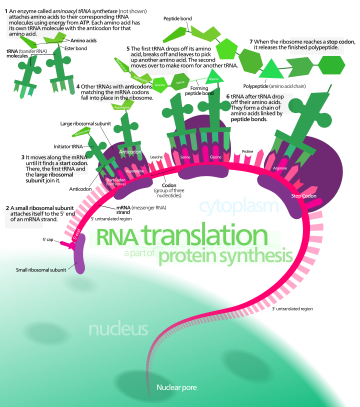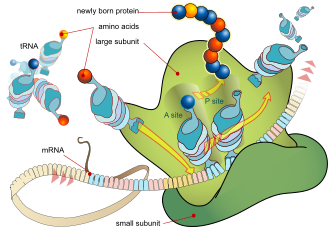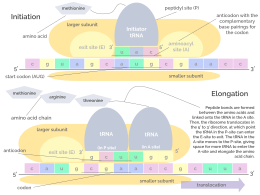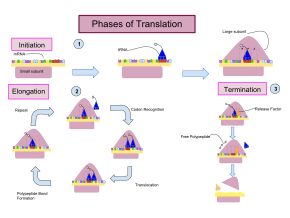
Back ترجمة (وراثة) Arabic Translyasiya Azerbaijani Трансляцыя (біялогія) Byelorussian Транслация (биология) Bulgarian ট্রান্সলেশন (জীববিজ্ঞান) Bengali/Bangla Translacija (biologija) BS Traducció (genètica) Catalan وەرگێڕان (زیندەزانی) CKB Translace (biologie) Czech Translation (biologi) Danish
| Part of a series on |
| Genetics |
|---|
 |




In biology, translation is the process in living cells in which proteins are produced using RNA molecules as templates. The generated protein is a sequence of amino acids. This sequence is determined by the sequence of nucleotides in the RNA. The nucleotides are considered three at a time. Each such triple results in addition of one specific amino acid to the protein being generated. The matching from nucleotide triple to amino acid is called the genetic code. The translation is performed by a large complex of functional RNA and proteins called ribosomes. The entire process is called gene expression.
In translation, messenger RNA (mRNA) is decoded in a ribosome, outside the nucleus, to produce a specific amino acid chain, or polypeptide. The polypeptide later folds into an active protein and performs its functions in the cell. The polypeptide can also start folding in the during protein synthesis[1]. The ribosome facilitates decoding by inducing the binding of complementary transfer RNA (tRNA) anticodon sequences to mRNA codons. The tRNAs carry specific amino acids that are chained together into a polypeptide as the mRNA passes through and is "read" by the ribosome.
Translation proceeds in three phases:
- Initiation: The ribosome assembles around the target mRNA. The first tRNA is attached at the start codon.
- Elongation: The last tRNA validated by the small ribosomal subunit (accommodation) transfers the amino acid. It carries to the large ribosomal subunit which binds it to one of the preceding admitted tRNA (transpeptidation). The ribosome then moves to the next mRNA codon to continue the process (translocation), creating an amino acid chain.
- Termination: When a stop codon is reached, the ribosome releases the polypeptide. The ribosomal complex remains intact and moves on to the next mRNA to be translated.
In prokaryotes (bacteria and archaea), translation occurs in the cytosol, where the large and small subunits of the ribosome bind to the mRNA. In eukaryotes, translation occurs in the cytoplasm or across the membrane of the endoplasmic reticulum through a process called co-translational translocation. In co-translational translocation, the entire ribosome/mRNA complex binds to the outer membrane of the rough endoplasmic reticulum (ER), and the new protein is synthesized and released into the ER; the newly created polypeptide can be stored inside the ER for future vesicle transport and secretion outside the cell, or immediately secreted.
Many types of transcribed RNA, such as tRNA, ribosomal RNA, and small nuclear RNA, do not undergo a translation into proteins.
Several antibiotics act by inhibiting translation. These include anisomycin, cycloheximide, chloramphenicol, tetracycline, streptomycin, erythromycin, and puromycin. Prokaryotic ribosomes have a different structure from that of eukaryotic ribosomes, and thus antibiotics can specifically target bacterial infections without any harm to a eukaryotic host's cells.
- ^ Liutkute, Marija; Maiti, Manisankar; Samatova, Ekaterina; Enderlein, Jörg; Rodnina, Marina V (2020-10-27). Hegde, Ramanujan S; Wolberger, Cynthia (eds.). "Gradual compaction of the nascent peptide during cotranslational folding on the ribosome". eLife. 9: e60895. doi:10.7554/eLife.60895. ISSN 2050-084X. PMC 7593090. PMID 33112737.